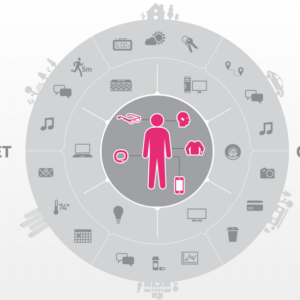When you think of Jawbone you don’t think of the “Internet of Things.” You think of fitness trackers, speakers and headsets. If this is your view of Jawbone, like mine used to be, you’d be wrong. The company has a vision for IoT and is well down the path to realizing that vision.
Today there are three categories that tend to dominate the wearable market related to activity trackers:
- Devices such as smartwatches and glasses that extend smartphone functionality. They don’t really fit the bill for an integrated solution, however, due to size, battery life and the lack of a 24-hour wearable form factor.
- Fitness/exercise/workout trackers have the same issues as the first category and many require additional sensors to take measurements.
- Lifestyle trackers, such as the Jawbone products, need to be comfortable for 24-hour wear, have an extended battery life, be something you can sleep in and basically disappear on you. In other words, you stop realizing that they are there.
 What do all of these solutions lack? Integration with other “things” and analytics that keep users engaged and using the products. Jawbone shared some statistics that dashboard-only products have a drop in usage after 90 days. Basically, users wear a product that tracks some statistics and then have to figure out how to either act on that data themselves or follow stock recommendations from the product that go to every user with a similar profile. This is exactly why I say wearables are boring. I agree that this model alone can’t have an extended life.
What do all of these solutions lack? Integration with other “things” and analytics that keep users engaged and using the products. Jawbone shared some statistics that dashboard-only products have a drop in usage after 90 days. Basically, users wear a product that tracks some statistics and then have to figure out how to either act on that data themselves or follow stock recommendations from the product that go to every user with a similar profile. This is exactly why I say wearables are boring. I agree that this model alone can’t have an extended life.
 Instead of the IoT, Jawbone talks about the Internet of You. In order to enable that vision there is hardware that you wear combined with software that pulls everything together in the cloud and analyzes it to create recommendations. While that might sound like the same process, the context makes it different. There’s a lot of discussion related to context across the telecommunications industry today, basically pertaining to services or traffic flows that have a specific behavior based on the context around them. What a service is being used for, who is using it, how the traffic flows, etc. In the world of IoT this is a new concept.
Instead of the IoT, Jawbone talks about the Internet of You. In order to enable that vision there is hardware that you wear combined with software that pulls everything together in the cloud and analyzes it to create recommendations. While that might sound like the same process, the context makes it different. There’s a lot of discussion related to context across the telecommunications industry today, basically pertaining to services or traffic flows that have a specific behavior based on the context around them. What a service is being used for, who is using it, how the traffic flows, etc. In the world of IoT this is a new concept.
So how would context apply in relation to an activity tracker and IoT? One of the examples Jawbone provided was smart thermostats. Today we can program them to adjust the temperature at certain times of the day, we can program them remotely if we are away and the situation at home changes, and we can track what the current temperature is when we’re not home and adjust it accordingly. But what if a smart thermostat knew what to do when you walked into the house and said “I’m cold” or “I’m hot.” Without the thermostat knowing what those terms mean to you specifically, the outcome might not be appropriate. Context requires a device to capture data about you, to be smart enough to interpret that data and then have the ability to link to other things.
Jawbone worked with data scientists to bring contextual awareness into its lifestyle products, and today the company’s platform allows integration with over 2,500 apps with more on the way. In September, Jawbone announced open APIs to enable interoperability with smartphones, watches and apps. The open platform is already working with the likes of Nest to connect your smart thermostat, as well as Whistle, to check out your dog’s daily movements. This is just a couple of real examples, more can be found on its website.
Why is all of this so important? As I said earlier, wearables alone are boring, and it seems the statistics agree with me. Being able to integrate wearables with the IoT is the first step toward longevity of the products and better understanding of their value by consumers, and hopefully results in more willingness to buy the products. Adding the data science to provide context opens up a whole new set of value-added services that could be developed. You wake up, your lights turn on, the temperature in your house changes, your coffee brews, your music plays and the car is warmed up and ready to go when you leave the house. That, I can see value in.
Like what you read? Follow me on twitter!
Claudia Bacco, Managing Director – EMEA for RCR Wireless News, has spent her entire career in telecom, IT and security. Having experience as an operator, software and hardware vendor and as a well-known industry analyst, she has many opinions on the market. She’ll be sharing those opinions along with ongoing trend analysis for RCR Wireless News.

